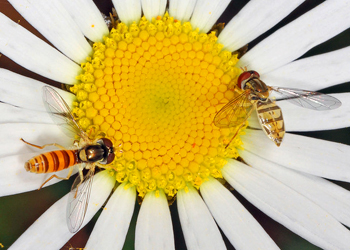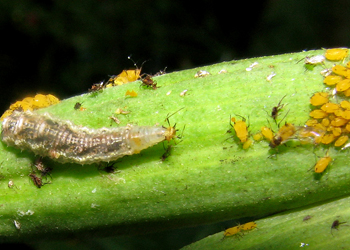Flower Flies

Syphrid flies; photo by Judy Gallagher, Flickr CC by 2.0
It’s a bee! No, it’s a fly!
Have you ever seen a fly masquerading as a bee in the garden? If so, then you may have encountered a flower or syrphid fly.
More than 130 species of flower flies are found in Maryland, and these animals serve both as important pollinators as well as predators in the garden.
Flower flies (family Syrphidae) are found throughout North America and often have conspicuous yellow or white and black stripes, which mimic the warning colorations on some bees and wasps. This mimicry coupled with buzzing noises often make flower flies less appealing to predators like birds. Unlike most bees, however, flower flies will hover over plants before going into consume nectar or pollen. Because of this trait, some flower flies are known as hover flies. Most flower flies in Maryland are less than 3/4 an inch in length.
Across the world, flies serve as important pollinators and assist with pollination of economically important plants like cacao (aka chocolate!) Flower flies feed off plants that have readily accessible nectar or pollen like violets (Viola spp.) and an assortment of asters.

Flower fly larvae gobble up Oleander aphids; photo by Kerry Wixted
As juveniles, flower fly larvae have very different feeding strategies than adults. Some flower fly larvae (maggots) are scavengers while others are predators. Flower flies in the genus Copestylum often sneak into bee or wasp nest to lay their eggs. Upon hatching, the larvae will feed on dead bees and other decaying material in the nest.
Other flower fly larvae feed upon soft-bodied creatures like thrips and aphids, including the non-native oleander aphids often found en masse on milkweed plants. Occasionally, butterfly eggs or early instar caterpillars will also be consumed by flower flies, but the few lost butterflies are not a cause for concern.
To attract flower flies to the garden, include plants in the carrot (Apicaceae) and mint (Lamiaceae) families like bee balms (Monarda).
Author’s Note
Spring has finally sprung! After a seemingly endless winter, I am excited to welcome warmer temperatures, spring flowers and wildlife into my backyard. This issue includes information on spring visitors like flower flies—a pollinator and a predator—as well as a beautiful native groundcover, moss phlox.
In addition, spring is a time for migration, which can be hazardous for many birds. Check out our article on bird-safe windows for tips on how to make your home more bird-friendly as well as some recommendations by guest author, Clare Walker, on plants that help pollinators but often deter deer.
If there is a particular topic that you would like to include, please don’t hesitate to reach out.
Happy Habitats!
Kerry Wixted
Click here to have HabiChat—the quarterly backyard wildlife habitat newsletter from the Wild Acres program—delivered right to your inbox!
In this Issue:
Bird Safe Windows
Deer Resistant Plants for Pollinators
Flower Flies
Moss Phlox


 1-888-373-7888
1-888-373-7888 233733
233733